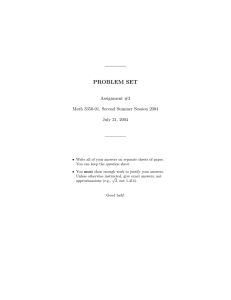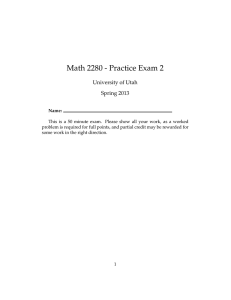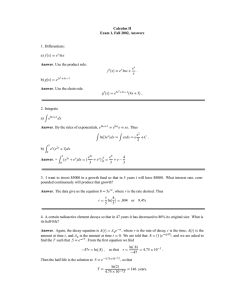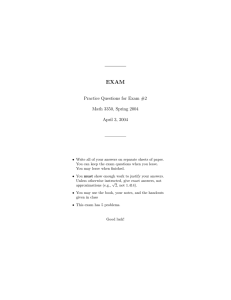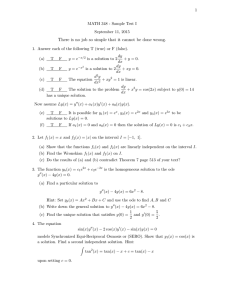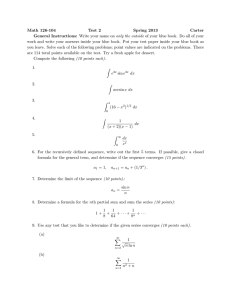Nonhomogeneous equations handout
advertisement
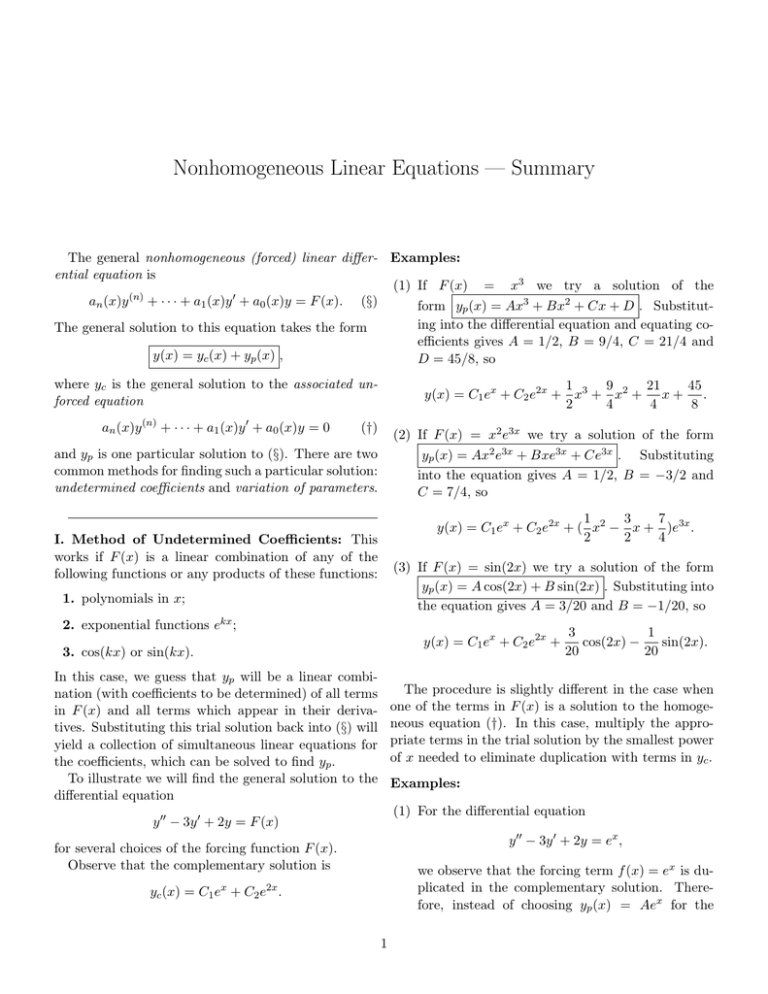
Nonhomogeneous Linear Equations — Summary The general nonhomogeneous (forced) linear differ- Examples: ential equation is (1) If F (x) = x3 we try a solution of the (n) 0 an (x)y + · · · + a1 (x)y + a0 (x)y = F (x). (§) form yp (x) = Ax3 + Bx2 + Cx + D . Substituting into the differential equation and equating coThe general solution to this equation takes the form efficients gives A = 1/2, B = 9/4, C = 21/4 and y(x) = yc (x) + yp (x) , D = 45/8, so where yc is the general solution to the associated unforced equation an (x)y (n) + · · · + a1 (x)y 0 + a0 (x)y = 0 9 21 45 1 y(x) = C1 ex + C2 e2x + x3 + x2 + x + . 2 4 4 8 (†) (2) If F (x) = x2 e3x we try a solution of the form yp (x) = Ax2 e3x + Bxe3x + Ce3x . Substituting into the equation gives A = 1/2, B = −3/2 and C = 7/4, so and yp is one particular solution to (§). There are two common methods for finding such a particular solution: undetermined coefficients and variation of parameters. 1 3 7 y(x) = C1 ex + C2 e2x + ( x2 − x + )e3x . 2 2 4 I. Method of Undetermined Coefficients: This works if F (x) is a linear combination of any of the following functions or any products of these functions: (3) If F (x) = sin(2x) we try a solution of the form yp (x) = A cos(2x) + B sin(2x) . Substituting into the equation gives A = 3/20 and B = −1/20, so 1. polynomials in x; 2. exponential functions ekx ; y(x) = C1 ex + C2 e2x + 3. cos(kx) or sin(kx). In this case, we guess that yp will be a linear combination (with coefficients to be determined) of all terms in F (x) and all terms which appear in their derivatives. Substituting this trial solution back into (§) will yield a collection of simultaneous linear equations for the coefficients, which can be solved to find yp . To illustrate we will find the general solution to the differential equation 3 1 cos(2x) − sin(2x). 20 20 The procedure is slightly different in the case when one of the terms in F (x) is a solution to the homogeneous equation (†). In this case, multiply the appropriate terms in the trial solution by the smallest power of x needed to eliminate duplication with terms in yc . Examples: (1) For the differential equation y 00 − 3y 0 + 2y = F (x) y 00 − 3y 0 + 2y = ex , for several choices of the forcing function F (x). Observe that the complementary solution is we observe that the forcing term f (x) = ex is duplicated in the complementary solution. Therefore, instead of choosing yp (x) = Aex for the yc (x) = C1 ex + C2 e2x . 1 trial solution, we try yp (x) = Axex . Substituting where W (x) = y1 (x)y20 (x) − y10 (x)y2 (x) into the equation and equating coefficients gives A = −1. The general solution is is the Wronskian of y1 and y2 . To find u1 and u2 we just have to integrate these expressions for u01 and u02 ; x 2x x y(x) = C1 e + C2 e − xe . in many cases, however, these integrals are impossible to evaluate in closed form. (2) For the differential equation Consider the two examples from before. y 00 − 2y 0 + y = ex , Examples: (1) y 00 − 3y 0 + 2y = ex . Here x the complementary solution is yc (x) = C1 e + y1 (x) = ex and y2 (x) = e2x C2 xex . We observe that the forcing term f (x) = ex is duplicated in the complementary solution. In solve the associated homogeneous equation. The this case, we must use the trial solution yp (x) = Wronskian of y1 and y2 is W (x) = e3x . Hence Ax2 ex . Substituting into the original equation and equating coefficients gives A = 21 . The general so(e2x )(ex ) (ex )(ex ) 0 0 u (x) = − = −1, u (x) = = e−x lution is 1 2 e3x e3x 1 y(x) = C1 ex + C2 xex + x2 ex . 2 so u1 (x) = −x, u2 (x) = −e−x , and yp (x) = (−x)(ex ) + (−e−x )(e2x ) = −ex − xex . II. Method of Variation of Parameters: This As before, the general solution is the sum of yp with method always works, but involves the computation of the general solution yc of the complementary equation. 00 0 x several integrals which in many cases cannot be done (2) y − 2y + y = e . Here in closed form. For simplicity we only consider the case n = 2, in other words, y1 (x) = ex and y2 (x) = xex y 00 + P (x)y 0 + Q(x)y = F (x). (‡) are linearly independent solutions to the associated homogeneous equation. The Wronskian of y1 and y2 is Let y1 and y2 be two linearly independent solutions to W (x) = e2x , whence y 00 + P (x)y 0 + Q(x)y = 0. Then a particular solution (xex )(ex ) (ex )(ex ) to (‡) is 0 u01 (x) = − = −x, u (x) = = 1, 2 e2x e2x yp (x) = u1 (x)y1 (x) + u2 (x)y2 (x), u1 (x) = − 21 x2 , u2 (x) = x, and where u1 and u2 satisfy the following two equations: yp (x) = (− 12 x2 )(ex ) + (x)(xex ) = 12 x2 ex . u01 (x)y1 (x) + u02 (x)y2 (x) = 0, (£) u01 (x)y10 (x) + u02 (x)y20 (x) = F (x). As before, the general solution is the sum of yp with the general solution yc of the complementary equation. The solution to (£) is y2 (x)F (x) 2 (x)F (x) u01 (x) = − y1 (x)yy0 (x)−y 0 (x)y (x) = − W (x) 2 2 1 and u02 (x) = y1 (x)F (x) y1 (x)y20 (x)−y10 (x)y2 (x) = y1 (x)F (x) W (x) , Notice that the particular solution in (2) is the same one which we found using the method of undetermined coefficients. This is not exactly the case in (1). Can you explain why the particular solutions which we found by these two methods are different and why this is not a contradiction?
